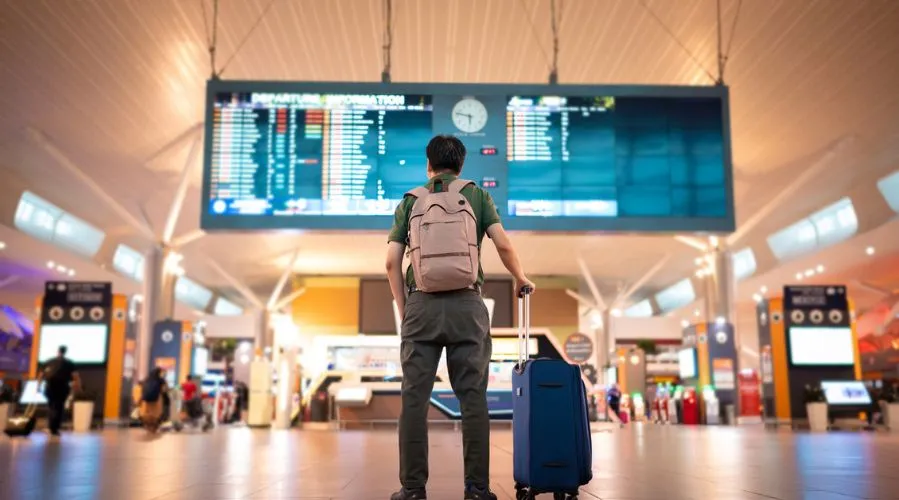NAME: Axel Strauss
DATE: 01/27/2025
Northwest of the Black Sea and between the Carpathian mountains lies the southeastern European Balkan gem that is Romania. And along with insulin, the fountain pen, the world’s earliest homo sapien fossils, and Dracula — this relatively young nation is home to countless historical, cultural, manmade, and natural wonders. So much so that it welcomes nearly 12 million modern international visitors a year — i.e., more than half its total population.
Meanwhile, if you’re hoping to visit Transylvania (and/or its surroundings) too, you’ll likely need the proper paperwork.
Especially ever since Romania officially joined the Schengen area. In which case, fear not — because AXA has all you need to know about a visa for Romania below.
- Do I need a visa to visit Romania?
- What type of Romanian visa do I need?
- What are the requirements for a Romanian Schengen visa?
- Where, when, and how should I apply for my Romanian visa?
- What about ETIAS and EES for Romania?
- How can AXA help me get my Romanian visa?
Do I need a visa to visit Romania?
Well, there’s about a 50/50 chance that you do. That’s because as of 2025 (and less than a year after Romania's (as well as Bulgaria’s) partial accession to the Schengen), the country has been a full-fledged member of the Schengen Zone*.
This means that it now requires most non-Schengen (and/or non-European Union) visitors to have a Schengen visa to cross its borders.
*PRO-TIP: If you’re curious about how borders work in Europe — AXA can tell you more about the remaining European non-Schengen countries (as well as the subtle but important differences between Europe, the European Union, the EEA, and the Schengen Area) too.
Which travelers are required to apply for a visa for Romania?
You’ll most likely need that Schengen visa for Romania if you’re a passport holder from one of the 100+ nations that have not signed a visa waiver agreement with the EU.
This generally includes citizens of Russia, most Middle Eastern and Asian nations (including China and India), and any country in Africa, for example.
Which travelers don’t need a Schengen visa to come to Romania (for stays of less than 90 days)?
Meanwhile, you won’t need that Schengen visa if you are:
- Already a national of the Schengen area and/or the European Union*;
- A citizen of one of the non-EU countries and territories that have signed visa exemption agreements with the EU — such as Australia, Brazil, Canada, Hong Kong, Japan, Macao, Mexico, Taiwan, the U.K., the U.S., and roughly 50 more nations.
In this case, you’re generally good to enter Romania with just your itinerary and biometric passport (issued no more than 10 years prior to and valid for at least 90 days after the planned date of departure from the Schengen zone, and so long as your stay doesn’t exceed three months in any six-month period).
PRO-TIPS: You can see full lists of countries whose citizens are/are not exempt from a Schengen visa courtesy of the European Commission.
And AXA can also tell you who needs a Schengen visa — Romanian or other — in no time too.
What type of visa for Romania do I need?
If you do indeed need a Schengen visa, you have a few options. The one you should choose will depend on what you’re planning to do in Romania — and for how long.
The most common choice for tourists, for example, is the short-stay visa (aka Type C, or just “tourist” visa). It will allow you to enjoy Bucharest, the capital of Romania, and all its Schengen surroundings — i.e., not just Romania — for up to 90 days in any 180-day period.
If you’re going to study, work — or if you’re simply passing through — there are specific visas for that too.
And if you plan on staying in Romania for more than three months — you’ll need what’s known as a Type D (aka “long-stay”, aka national) visa.
PRO-TIP: AXA has all you need to know about each type of Schengen visa too — as well as Schengen visa validity, all the Schengen visa requirements, and more. So explore!
What are the requirements for a Romanian Schengen visa?
Speaking of the requirements*, the specific paperwork and criteria you’ll need for Romania will, of course, depend on both your type of visa and the specific nature of your trip.
Generally speaking, however, you should have the following before you apply (and at the very least):
- Your passport (issued within the last 10 years, with a validity of more than 3 months after the planned date of exit from the Schengen area)
- A Schengen visa application form — duly completed and signed
- Two recent passport photos
- Your itinerary (PRO-TIP: AXA can explain the flight itinerary for a Schengen visa too)
- Schengen travel insurance (NOTE: Travel insurance is mandatory to be granted your visa. Moreover, your plan must meet several criteria; fortunately, AXA’s plans do!)
- Proof of sufficient funds (if applicable)
- Proof of the purpose of the trip (i.e., letter of invitation, if applicable)
- Your residence permit and/or resident card (if applicable)
- Proof of accommodation (if applicable)
- Proof of socio-economic and professional stability (if applicable)
- For minors — certified parental or guardian authorization
*IMPORTANT PRO-TIP: AXA consistently strives to bring you the most up-to-date and accurate info regarding any and all Schengen Visa requirements. That said, it’s always best to consult the official sources — especially considering that Romania is one of the new kids on the block, Schengen-wise.
In other words, before you apply, make sure to double-check:
- -the European Commission’s official visa website;
- -that of your home country;
- -and — most importantly — that of Romania’s Ministry of Foreign Affairs.*
Where, when, and how should I apply for my Romanian visa?
And to apply, follow these simple steps:
Where to apply
You’ll be submitting your initial Romanian Schengen visa application online.
*The official website above, for example, states that “in order to facilitate the issue of visas, the Ministry of Foreign Affairs restructured the eVisa electronic portal, which can be accessed 24/7 at address http://evisa.mae.ro/, with the aim of reducing the waiting time at a diplomatic mission/consulate and at streamlining the visa application process.” At some point, however, you will be directed to the nearest Romanian embassy/consulate in your place of residence.
PRO-TIP: But fear not — Romania’s Ministry of Foreign Affairs provides a list of all Romanian missions worldwide too.
When to apply
According to said Ministry, “it is highly recommended that visa applications be lodged at least 2 weeks before the estimated date of departure and not more than 3 months before that date. The date from which the period of taking a decision upon a visa application is the date when the visa applicant presents oneself at the diplomatic mission/consular post of Romania.”
PRO-TIP: But remember that even though you can begin the process online, you'll eventually need to visit an embassy, consulate, and/or visa application center in person — for biometrics collection and document submission. So plan ahead.
How to apply
Again, Romania’s Ministry of Foreign Affairs should tell you all you need to know (via email — once you begin the “e-visa” process, that is). But, just in case, here’s a general summary of your steps:
- Check your local Romanian embassy/consulate’s specific application guidelines (as requirements vary by region);
- Fill out and email the online form;
- Book your appointment accordingly;
- Attend the scheduled in-person interview and submit the rest of your application (i.e., the documents* above).
*IMPORTANT PRO-TIP: The website also states that “it is advisable that your supporting documents be translated into Romanian or English by an authorized translator. All documents you submit must be legible. All attached documents must be presented in original and copy when you visit the Romanian diplomatic mission / consular post.”
And then — well, just wait to hear back and hope for the best! AXA’s rooting for you.*
*PRO-TIP: And while we are, we can tell you all about Schengen Visa Processing Times too.
What about ETIAS and EES for Romania?
You may have already heard of these as well. If not — the “European Information and Authorization System” (aka ETIAS) and its counterpart the “Entry/Exit System” (aka EES) are the European Union’s long-awaited, mostly digital systems of new requirements for entering its borders.
While designed to make travel both easier and safer for everyone, it’s important to understand that ETIAS and EES will not replace the Schengen visa (for Romania or anywhere else). Instead, they will apply to any non-EU travelers from the roughly 60 visa-exempt countries mentioned above.
PRO-TIP: AXA can tell you more about the details of both ETIAS and EES. But for the latest updates, it’s best to consult the EU’s official website — since as of early 2025, both systems were still very much in the works.
How can AXA help me get my Romanian visa?
And before you get the ball rolling on Romania, the best possible way AXA can actually help you get that visa — and have a safe trip all around — is by doing what we do best.
And that’s providing you and your loved ones with some first-class, top-quality, affordable travel insurance for Romania.
Because, again, to be granted your Romanian visa, Schengen travel insurance is mandatory. Moreover, your plan must meet certain health insurance requirements. And all three of AXA’s plans do, of course.
But along with visa eligibility, there are countless other benefits to choosing AXA — from no age restrictions or medical exams to 24/7 support, free remote doctor consultations (in multiple languages), beyond-Schengen coverage, and more.
So as you gather your visa paperwork and check those ticket prices, we recommend you take a minute to
compare AXA’s different plans and get a free AXA quote.
Because with AXA, you’re one big step closer to exploring Romania both legally, and stress-free — with the added benefit of knowing you and your family are in good hands 24/7 once you’re there.
So călătorii în siguranță (that’s Romanian for “safe travels”) — and best of luck!
RELATED ARTICLES
- Schengen visa costs
- How to fill out the Schengen visa application form
- Schengen visa tracking online
FAQ
Can I work or study in Romania with a Schengen tourist visa?
No. A tourist (aka “short-stay” or Type C) Schengen visa allows entry into Romania for vacation, short business trips, visiting family, or attending short school courses (such as language classes, for example). It cannot, however, be used as (or converted into) an official work or study permit once you’re there.
Can I visit other countries on a Romania Schengen visa?
Yes, you can travel throughout the rest of the Schengen on a Romanian visa for up to 90 days in any 180-day period — so long as Romania is either your main destination (i.e., where you’ll spend the most time) or your first entry point in the Schengen Area.
Does Romania use the Euro?
No. The Romanian currency is Leu (RON) — or Lei (plural), and Euros for cash payments are generally not accepted.
FINAL PRO-TIP: As of early 2025, 1 Euro is roughly 5 Lei — but you should check the latest official exchange rates via the Romanian National Bank.
AXA already looks after millions of people around the world
With our travel insurance we can take great care of you too
AXA Schengen's Travel Insurances

AXA Schengen Low Cost
AXA Schengen Low Cost is perfect to obtain your Schengen visa. This travel insurance meets all the requirements demanded, covers you in all the countries of the Schengen Area as well as 4 European microstates (Andorra, Vatican City, Monaco and San Marino).

AXA Schengen Europe Travel
AXA Europe Travel is perfect to obtain your Schengen visa. It provides coverage in all the Schengen countries + the European microstates + all the EU countries (including UK, Cyprus and the Republic of Ireland). And you get additional guarantees compared to AXA Schengen Low Cost.

AXA Schengen Multi Trip
AXA Multi Trip is perfect to obtain your Schengen visa. This annual travel insurance is ideal for those who often travel to Europe as well as multiple-entry Schengen visa holders. You get the same guarantees as AXA Schengen Multi Trip for different countries during 90 days.


